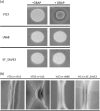The incongruent gelatinase genotype and phenotype in Enterococcus faecalis are due to shutting off the ability to respond to the gelatinase biosynthesis-activating pheromone (GBAP) quorum-sensing signal
- PMID: 22117005
- PMCID: PMC4083509
- DOI: 10.1099/mic.0.055574-0
The incongruent gelatinase genotype and phenotype in Enterococcus faecalis are due to shutting off the ability to respond to the gelatinase biosynthesis-activating pheromone (GBAP) quorum-sensing signal
Abstract
The concomitant presence of a complete fsr quorum-sensing system and gelE-sprE operons in Enterococcus faecalis is known to be essential for the detection of gelatinase activity. However, there are reports of the absence of gelatinase activity despite the presence of complete fsr and gelE loci. In order to understand this incongruence between genotype and phenotype we sequenced fsr and gelE loci of the E. faecalis LN68 strain, which was previously found to carry both operons but to lack gelatinase activity. Of the 59 nucleotide differences detected compared with the gelatinase-positive V583 strain, we found a nonsense mutation (a premature STOP codon) predicted to truncate the ATPase sensor domain of the FsrC protein, responsible for sensing and transducing the signal from the quorum-sensing molecule. Strain LN68 was highly affected in the expression of the gelE and sprE genes, further supporting the lack of Fsr-dependent gelE induction. When we constructed a V583 mutant with the same premature stop mutation in the fsrC gene the resulting strain was no longer able to degrade gelatin. We conclude that the reduced ability to transduce the quorum-sensing signal of the prematurely truncated FsrC protein is sufficient to explain the negative gelatinase phenotype. As the incongruent genotype and phenotype is detected in natural isolates, we believe that the silencing of the quorum-sensing system Fsr may be beneficial for some E. faecalis strains.
Figures





Similar articles
-
Gelatinase biosynthesis-activating pheromone: a peptide lactone that mediates a quorum sensing in Enterococcus faecalis.Mol Microbiol. 2001 Jul;41(1):145-54. doi: 10.1046/j.1365-2958.2001.02486.x. Mol Microbiol. 2001. PMID: 11454207
-
Siamycin attenuates fsr quorum sensing mediated by a gelatinase biosynthesis-activating pheromone in Enterococcus faecalis.J Bacteriol. 2007 Feb;189(4):1358-65. doi: 10.1128/JB.00969-06. Epub 2006 Oct 27. J Bacteriol. 2007. PMID: 17071762 Free PMC article.
-
The fsr Quorum-Sensing System and Cognate Gelatinase Orchestrate the Expression and Processing of Proprotein EF_1097 into the Mature Antimicrobial Peptide Enterocin O16.J Bacteriol. 2015 Jul;197(13):2112-2121. doi: 10.1128/JB.02513-14. Epub 2015 Mar 2. J Bacteriol. 2015. PMID: 25733609 Free PMC article.
-
Molecular Mechanism of Quorum-Sensing in Enterococcus faecalis: Its Role in Virulence and Therapeutic Approaches.Int J Mol Sci. 2017 May 3;18(5):960. doi: 10.3390/ijms18050960. Int J Mol Sci. 2017. PMID: 28467378 Free PMC article. Review.
-
Signal transduction, quorum-sensing, and extracellular protease activity in Enterococcus faecalis biofilm formation.J Bacteriol. 2004 Dec;186(24):8161-3. doi: 10.1128/JB.186.24.8161-8163.2004. J Bacteriol. 2004. PMID: 15576763 Free PMC article. Review. No abstract available.
Cited by
-
The Phosphatase Bph and Peptidyl-Prolyl Isomerase PrsA Are Required for Gelatinase Expression and Activity in Enterococcus faecalis.J Bacteriol. 2022 Jul 19;204(7):e0012922. doi: 10.1128/jb.00129-22. Epub 2022 Jun 3. J Bacteriol. 2022. PMID: 35657705 Free PMC article.
-
Drosophila host model reveals new enterococcus faecalis quorum-sensing associated virulence factors.PLoS One. 2013 May 29;8(5):e64740. doi: 10.1371/journal.pone.0064740. Print 2013. PLoS One. 2013. PMID: 23734216 Free PMC article.
-
Enterococcus spp.: Is It a Bad Choice for a Good Use-A Conundrum to Solve?Microorganisms. 2021 Oct 26;9(11):2222. doi: 10.3390/microorganisms9112222. Microorganisms. 2021. PMID: 34835352 Free PMC article. Review.
-
The Enterococcus faecalis exoproteome: identification and temporal regulation by Fsr.PLoS One. 2012;7(3):e33450. doi: 10.1371/journal.pone.0033450. Epub 2012 Mar 12. PLoS One. 2012. PMID: 22428053 Free PMC article.
-
Enterococcus faecalis Promotes Innate Immune Suppression and Polymicrobial Catheter-Associated Urinary Tract Infection.Infect Immun. 2017 Nov 17;85(12):e00378-17. doi: 10.1128/IAI.00378-17. Print 2017 Dec. Infect Immun. 2017. PMID: 28893918 Free PMC article.
References
-
- Bourgogne A., Hilsenbeck S. G., Dunny G. M., Murray B. E. (2006). Comparison of OG1RF and an isogenic fsrB deletion mutant by transcriptional analysis: the Fsr system of Enterococcus faecalis is more than the activator of gelatinase and serine protease. J Bacteriol 188, 2875–2884. 10.1128/JB.188.8.2875-2884.2006 - DOI - PMC - PubMed
Publication types
MeSH terms
Substances
Associated data
- Actions
Grants and funding
LinkOut - more resources
Full Text Sources
Research Materials

